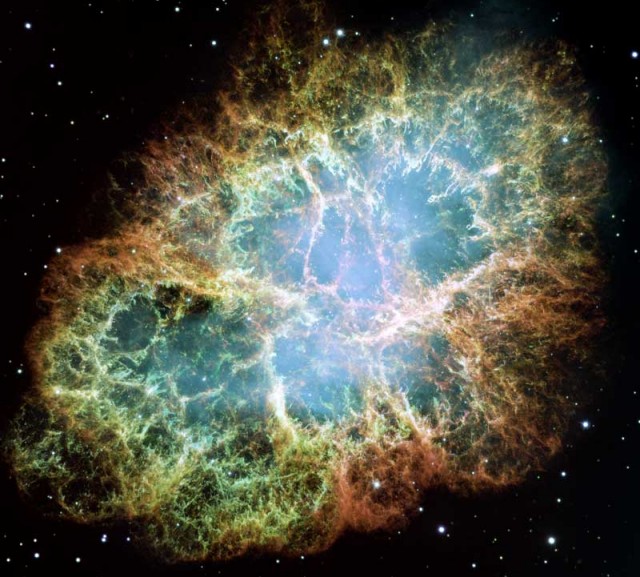Credit & Copyright: NASA,
ESA,
J. Hester, A. Loll (ASU)
Acknowledgement: Davide De Martin (Skyfactory)
Explanation:
The Crab Nebula is cataloged as M1, the first object on
Charles
Messier's famous list of things which are not comets.
In fact, the
cosmic Crab
is now known to be a
supernova remnant,
an expanding cloud of debris from the death explosion of a massive star.
Light from that stellar catastrophe was first
witnessed
by astronomers on planet Earth in the year 1054.
Composed of 24
exposures taken in October 1999, January 2000,
and December 2000, this
Hubble Space Telescope mosaic spans about six light years.
Colors in the intricate filaments trace the light emitted from atoms
of hydrogen, oxygen, and sulfur in the debris cloud.
The erie blue interior glow is emitted by high-energy electrons
accelerated by the
Crab's central pulsar.
One of the most exotic objects known to modern astronomers,
the pulsar is
a neutron star, the spinning remnant of the
collapsed stellar core.
The Crab Nebula lies about 6,500 light-years away in the
constellation
Taurus.
Acknowledgement: Davide De Martin (Skyfactory)
1999 2000 2001 2002 2003 2004 2005 2006 2007 2008 2009 2010 2011 2012 2013 2014 2015 2016 2017 2018 2019 2020 2021 2022 2023 2024 2025 |
Yanvar' Fevral' Mart Aprel' Mai Iyun' Iyul' Avgust Sentyabr' Oktyabr' Noyabr' Dekabr' |
NASA Web Site Statements, Warnings, and Disclaimers
NASA Official: Jay Norris. Specific rights apply.
A service of: LHEA at NASA / GSFC
& Michigan Tech. U.
|
Publikacii s klyuchevymi slovami:
Crab Nebula - M 1 - supernova remnant - pulsar - Krabovidnaya tumannost' - ostatok Sverhnovoi - Pul'sar
Publikacii so slovami: Crab Nebula - M 1 - supernova remnant - pulsar - Krabovidnaya tumannost' - ostatok Sverhnovoi - Pul'sar | |
Sm. takzhe:
Vse publikacii na tu zhe temu >> | |
